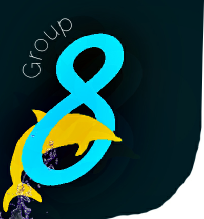
Falmouth Group 8

DISCLAIMER! This website does not necessarily reflect the views expressed by the National Oceanography Centre or any of its staff.

Habitat 1: Rocky substrate; Dominated by rocky substrate and characterised by kelp forest contining species such as Laminaria digitata. A number of juvinile fish were seen in this habitat.
Habitat 2: Coarse sand sediment; absence of large algal growth due to the lack of suitable substrate. There is an increase in filter and desposit feeders.
Habitat 3: Mearl bed; The open lattice structure of the mearl acts as a biostabiliser in the coarse sand sediments. This reduces the amount of burrowing fauna and increases the amount meiofauna present.
Habitat 4: Ripple formation; formed by wave action with an average height of 0.35m.
The flora species present match the classification of tide swept open coast areas, according to SAC 1160 Annex 1 habitats. The kelp forests (L. hyperborea, and L. digitata) appeared where the current was strong and the water column was dense with marine snow. These species dominated the rocky sunstrate boundaries. The fronds of the L. digitata were densely covered with hyroid polyps (segementation visible). Mixed maerl and sand sediments were patchily distributed throughout the lower transect, (nearest to the SAC 1110 maerl beds of St. Mawes). Where the maerl beds were present the water column appeared to be clearer and the marine snow was minimal. The more sheltered conditions consisted of sandy and gravelly sediments and the algae species were in mixed abundance including. Sugar kelp (L. saccharina), (Chondrus crispus, Alaria esculenta, Enteromorpha intestinalis, Ulva lochnea and corallina officinalis.
Fauna species also matched SAC classifications. The kelp forests (L. hyperborea and L.digitata) provided nursery grounds for juvenile fish including numerous species of wrasse (Labrus bergylta, L. mixtus, Coris julis), and Pollack (Pollachius pollachis). Breaks in the kelp allowed sponges to attach to rocky substrates (Grantia compressa and Verongia aerophoba), and echinoderms (edible sea urchin). The coarse sands were sparsely covered in algal growth however; the fauna was dominated by starfish (Luidia ciliaris, Astropecten irregularis and Astropecten aranciacus).
Flora and Fauna
Transects were occasionally blocked or slowed by other boat traffic. This is seen quite clearly in transect 3, where loss of speed caused by a slow moving yacht led to an area of illegible data and the elongation of the printout for this transect. Transects 1 and 2 had significant overlap, which offered a different perspective as to gain information on the side scan, however it made interpretation of the data difficult. Bucket grabs and diver surveys were not undertaken, although video corroborated has attempted to minimize this.
Limitations
Habitat Map